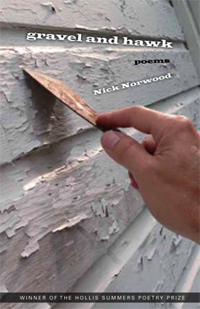 Gravel and Hawk
Gravel and Hawk
by Nick Norwood
Ohio University Press, 2012
72 pages / $16.95 Buy from Ohio University Press or Amazon
The traditional story of the south: barns, fields, dilapidated gas stations, grandparents, a keen sense of rhythm, and a pronounced attention to the detail of these things. Family stories filled with fairly controlled amounts of emotion and longing and romanticism. Qualities like these flare in Nick Norwood’s latest collection, Gravel and Hawk, out from Ohio University Press. It’s a book of family and most certainly of place. The moving lens of the speaker hovers over these components for various amounts of time and in various patterns, chopping up the focus so that the southern tale might not get too long-winded.
Norwood uses his focus on the South to expose the relationship between people and place throughout the collection. At least, the opportunities are there and some exposure is developed. He constructs a short sequence near the middle of the book simply called “Buildings,” in which various buildings around this hometown are examined in various lights. Some focus on the items lying around the place while others describe past events on the property, memories and injuries. I’m reminded right away during the first of these poems, called “Filling Station,” of — obviously — the Elizabeth Bishop poem of the same name. While Norwood’s gas station has some beautiful imagery, such as the opening line “The dirt driveway is potbelly black, / jeweled with bottle caps and broken glass,” the poem doesn’t do what Bishop’s does so well: connect the place with its people. And in a collection so focused on the people and family of the South, it seems to me more importance should be applied to this connection.
Later in the same sequence, a poem titled “Field Shed” does accomplish this connection, and it does it well. Here the farmer walks among the many still and silent dangers sitting in the shed. “He walks in a vapor, drags it like a mean spirit / a half step behind. Where he stops it hovers. / His father’s harness hangs on the wall.” The man now has a past, a father, has concerns and threats, “mean spirits,” and all these things that a place can and should bring to its residents. Finally we have connections. Finally we have the South.
The sentence-level work at play here is super economical and tight, focusing on getting straight to the imagery while letting that economy pronounce the internal rhythms as much as possible. In “Storm Cellar,” these qualities show through strongly:
floor hoodooed with a scatter of seed potatoes,
walls hung with bulbs bulging burlap sacks.
Onion fumes.
Here the image is clear, textures smells and atmosphere are all starkly present, and the language itself is brief and contained. Here, too, shows the sound-play Norwood so enjoys mixing into his work. Though I find this sound-play a bit distracting at times, it’s in poems like this — with the strong, perhaps potent, alliteration — that I appreciate it in its brevity. Other times, as in the poem “Firewood,” the sound-play seems accidental and therefore, as I said, distracting:
into oak side. Maul and wedge pa-ching, pa-ching,
pa-ching, the ring disappearing
Again, clearly, an honest attempt at enjoyable and perhaps folksy sound-work is at hand here, but it seems that it’s trying too hard to accomplish all that. The damn “ing” sound is much too much for my ears, though I’ll admit the italicized sound-effects are dead-on accurate. It’s moments like these where I find the struggle of balancing poetic soundplay with some type of folksy southern story to be exposing itself like a bone breaking through flesh, where just seeing it lets your gut know that something is wrong. But, again, I can appreciate this type of play in its brevity and for its strengths.
The language within the book does lend itself to some cohesiveness. As I read on, I could always tell it’s the same voice producing these poems, but the language is often varied just enough in each poem where it doesn’t get too droll or dull as it moves forward. Subtle things like listing in a poem or forming a set of instructions help with this. But it’s not too obvious as you’re reading it because the attitude and descriptive qualities are fairly consistent throughout. As a book with one solid theme, the mix between consistency and variety is important.
To keep this constant theme from becoming too static, Norwood employs a few sets of arcs, including the “Buildings” sequence mentioned earlier. He later begins a very similar exploration of buildings in a short set, and then, unannounced and very subtly, a cow — that’s right — sequence occurs that sheds an honest, real light on the human-animal connection that inevitably happens on a farm, and explores how that revolves around the lifespan of each creature.
To cap off and hammer home its intense focus on family (as well as connecting family to place), a large handful of the poems end with a note signifying their being in memory of one person or another. Emotionally, though this gets a bit tiring, it puts an entirely different spin on each poem with such a note, and on the entirety of the book. Because of the surprisingly large number of these types of poems, the book itself becomes a kind of memorial, a tombstone, a prayer. It adds
this real power to the collection, connecting the poems much closer to the poet, and bringing the reader along in the memory-exploring.
***
Tags: C.J. Opperthauser, Gravel and Hawk, Nick Norwood
